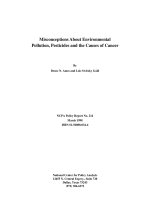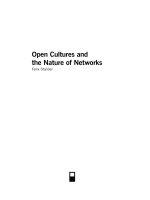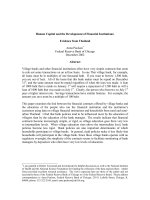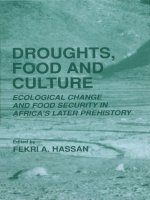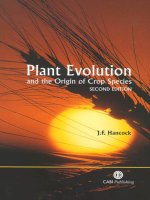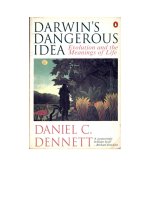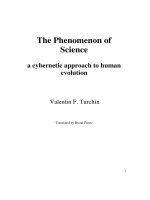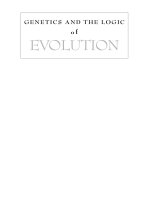Teaching About Evolution and the Nature of Science - NAP (2004) Episode 9 docx
Bạn đang xem bản rút gọn của tài liệu. Xem và tải ngay bản đầy đủ của tài liệu tại đây (123.25 KB, 15 trang )
videos, and software)? (See Worksheet 5 on page
119 in the back of this chapter.)
2. Does the teacher’s guide contain suggestions
for effectively managing materials?
3. Do the instructional materials call for equip-
ment, supplies, and technology that teachers may
not have?
4. Do the instructional materials identify safety
issues and provide adequate precautions?
5. Is the cost for materials and replacements
reasonable? Are there special requirements?
NOTES
1. Rodger Bybee. 1997. Achieving Scientific Literacy: From
Purposes to Practices
. Portsmouth, NH: Heinemann.
Rodger Bybee, 1996.
National Standards and the Science
Curriculum
. Dubuque, IA: Kendall/Hunt Publishing Co.
2. N. M. Lambert and B. L. McCombs. 1998.
How Students
Learn: Reforming Schools Through Learner-Centered
Education.
Washington, DC: American Psychological
Association.
3. National Research Council. 1996.
National Science
Education Standards
. Washington, DC: National Academy
Press, p. 22. www.nap.edu/readingroom/books/nses
4. M.G. Fullan and S. Stiegelbauer. 1991.
The New Meaning of
Educational Change
, 2nd ed. New York: Teachers College
Press, Columbia University.
G.E. Hall and S.M. Hord. 1987.
Change in Schools:
Facilitating the Process
. Albany: State University of New
York Press.
S. Loucks-Horsley and S. Stiegelbauer. 1991. Using
Knowledge of Change to Guide Staff Development. In
Staff
Development for Education in the 90s: New Demands, New
Realities, New Perspectives
. A. Lieberman and L. Miller, eds.
New York: Teachers College Press, Columbia University.
5. See
National Science Education Standards, p. 158.
6. See
National Science Education Standards, pp. 55-73.
•
111
CHAPTER 7
Selecting Instructional Materials
Copyright 2004 © National Academy of Sciences. All rights reserved.
Unless otherwise indicated, all materials in this PDF File provided by the National Academies Press (www.nap.edu) for research
purposes are copyrighted by the National Academy of Sciences. Distribution, posting, or copying is strictly prohibited without
written permission of the NAP.
Generated for on Sat Oct 9 17:18:26 2004
/>Teaching About
Evolution and the Nature of Science
112
•
1. Terms (fundamental concepts) Location Page(s)
evolution
diversity
adaptation
interpreting fossil evidence
techniques for age determination
natural selection
descent from common ancestors
experiments
evidence
explanations
models
theory
skepticism
Comments on breadth and depth of coverage:
2. Statements of expected student outcomes Location Page(s)
on evolution and the nature of science
Examples:
a.
b.
c.
Worksheet 1: General Overview
Copyright 2004 © National Academy of Sciences. All rights reserved.
Unless otherwise indicated, all materials in this PDF File provided by the National Academies Press (www.nap.edu) for research
purposes are copyrighted by the National Academy of Sciences. Distribution, posting, or copying is strictly prohibited without
written permission of the NAP.
Generated for on Sat Oct 9 17:18:26 2004
/>•
113
CHAPTER 7
Selecting Instructional Materials
Worksheet 1: (Continued)
3. Student investigations Location Page(s)
Titles of example investigations:
a.
b.
c.
Comments:
4. Concept Level Location Page(s)
Paragraph 1
Comments:
Paragraph 2
Comments:
Statement of overall impression from the overview:
Copyright 2004 © National Academy of Sciences. All rights reserved.
Unless otherwise indicated, all materials in this PDF File provided by the National Academies Press (www.nap.edu) for research
purposes are copyrighted by the National Academy of Sciences. Distribution, posting, or copying is strictly prohibited without
written permission of the NAP.
Generated for on Sat Oct 9 17:18:26 2004
/>Teaching About
Evolution and the Nature of Science
114
•
A. CONTENT
1. Fundamental understandings addressed: Location Page(s)____
List of fundamental understandings:
2. Do materials promote understanding of the subject matter?
a. Content Standard C: Life Science, or Standard D: Earth and Space Science
Fundamental understanding statement: _________________________ Page(s)____
__________________________________________________________
Level of understanding possible based on
the opportunities to learn: Thorough [ ] Some [ ] None [ ]
Comments:
b. Content Standard C: Life Science, or Standard D: Earth and Space Science
Fundamental understanding statement: _________________________ Page(s)____
__________________________________________________________
Level of understanding possible based on
the opportunities to learn: Thorough [ ] To some degree [ ] Topic match only [ ]
Comments:
3. Student Investigations
Investigation title: __________________________________________ Page(s)_____
Learning goal: ______________________________________________
__________________________________________________________
The activity alignment between learning goal and
National Science Education
Standards
fundamental understanding: Excellent [ ] Partial [ ] None [ ]
Comments:
Worksheet 2: Analysis of Science Subject Matter
Copyright 2004 © National Academy of Sciences. All rights reserved.
Unless otherwise indicated, all materials in this PDF File provided by the National Academies Press (www.nap.edu) for research
purposes are copyrighted by the National Academy of Sciences. Distribution, posting, or copying is strictly prohibited without
written permission of the NAP.
Generated for on Sat Oct 9 17:18:26 2004
/>•
115
CHAPTER 7
Selecting Instructional Materials
Worksheet 2: (Continued)
B. SCIENTIFIC INQUIRY
1. What opportunities are provided for students to develop abilities
of scientific inquiry?
Cite specific examples: Page(s)____
a. to pose relevant questions; ____
b. plan and conduct investigations; ____
c. use appropriate tools and techniques to gather data; ____
d. use evidence to communicate defensible explanations of cause and effect; ____
e. use scientific criteria to analyze alternative explanations and
develop a preferred explanation. ____
Discussion of examples:
2. Opportunities to develop understanding
of scientific inquiry: Page(s)____
Cite specific examples:
a. discussion of both roles and limitations of skills such as organizing
and interpreting data, constructing explanations; ____
b. discussion of how science advances through legitimate skepticism; ____
c. discussion of how scientists evaluate proposed explanations of others
by examining and comparing evidence, reasoning that goes beyond
the evidence, suggesting alternative explanations for the same evidence; ____
d. opportunities for students to demonstrate these same understandings
as a part of their investigations. ____
Discussion of examples:
Overall estimate of alignment with National Science Education Standards Inquiry Standard:
Excellent [ ] Good [ ] Some [ ] Little [ ] None [ ]
Justification of alignment estimate:
Copyright 2004 © National Academy of Sciences. All rights reserved.
Unless otherwise indicated, all materials in this PDF File provided by the National Academies Press (www.nap.edu) for research
purposes are copyrighted by the National Academy of Sciences. Distribution, posting, or copying is strictly prohibited without
written permission of the NAP.
Generated for on Sat Oct 9 17:18:26 2004
/>Teaching About
Evolution and the Nature of Science
116
•
C. HISTORY AND NATURE OF SCIENCE
Cite specific examples of:
1. evidence supporting the role of scientists, human insight, and Page(s)_____
scientific reasoning in the historical development of explanations
for evolution;
2. narrative and learning activities that provide examples of how
explanations are developed, reviewed by peers, and revised in
light of new evidence and thinking; _____
3. specific reference to historical contributions of scientists in the
development of fundamental understandings of evolution; _____
4. opportunities for students to demonstrate how scientific explanations
are developed, reviewed by peers, and revised in light of new evidence
and thinking. _____
Discussion of examples:
Overall estimate of alignment with National Science Education Standards History
and the Nature of Science Standard
Excellent [ ] Good [ ] Some [ ] Little [ ] None [ ]
Justification of alignment estimate:
Worksheet 2: (Continued)
Copyright 2004 © National Academy of Sciences. All rights reserved.
Unless otherwise indicated, all materials in this PDF File provided by the National Academies Press (www.nap.edu) for research
purposes are copyrighted by the National Academy of Sciences. Distribution, posting, or copying is strictly prohibited without
written permission of the NAP.
Generated for on Sat Oct 9 17:18:26 2004
/>•
117
CHAPTER 7
Selecting Instructional Materials
Cite specific examples where:
1. student learning goals or outcomes focus on one or more fundamental
understandings in evolution and the nature of science specified in
Content Standards A, C, D, and G; Page(s)_____
Comments:
2. materials engage and focus student thinking on interesting questions,
problems, or relevant issues; rather than opening with statements of
fact and vocabulary; _____
Comments:
3. materials provide a sequence of learning activities connected in such
a way as to help students build understanding of a fundamental concept. _____
Does the material provide specific means (e.g., connections among activities,
linkage between text and activities, building from concepts to abstract
and embedded assessments) to help the teacher keep students focused
on the purpose of the lesson? Yes _______ No______ _____
Comments:
4. teacher’s guide presents common student misconceptions about
evolution and the nature of science; _____
suggestions are provided to access prior understandings of students; and _____
student learning activities are designed to help students confront
misconceptions and encourage conceptual change. _____
Comments:
Overall estimate of alignment to National Science Education Standards Teaching Standard
Excellent [ ] Good [ ] Some [ ] Little [ ] None [ ]
Justification of alignment estimate:
Worksheet 3: Analysis of Pedagogy
Copyright 2004 © National Academy of Sciences. All rights reserved.
Unless otherwise indicated, all materials in this PDF File provided by the National Academies Press (www.nap.edu) for research
purposes are copyrighted by the National Academy of Sciences. Distribution, posting, or copying is strictly prohibited without
written permission of the NAP.
Generated for on Sat Oct 9 17:18:26 2004
/>Teaching About
Evolution and the Nature of Science
118
•
Worksheet 4: Analysis of Assessment Process
Cite example or evidence of:
1. consistency between learning goals and assessment; Page(s)_____
2. assessments stressing application of concepts to new or
different situations; _____
3. fairness of assessment tasks for all students—for example, task
does not rely too heavily upon the student’s ability to read
complex items or write explanations, as opposed to understanding
the fundamental concepts; and _____
4. the inclusion of actual assessment instruments, scoring criteria
or rubrics, and specific suggestions provided regarding their use. _____
Comments:
Overall estimate of alignment to National Science Education Standards Assessment Standard:
Excellent [ ] Good [ ] Some [ ] Little or None [ ]
Explanation of alignment estimate:
Copyright 2004 © National Academy of Sciences. All rights reserved.
Unless otherwise indicated, all materials in this PDF File provided by the National Academies Press (www.nap.edu) for research
purposes are copyrighted by the National Academy of Sciences. Distribution, posting, or copying is strictly prohibited without
written permission of the NAP.
Generated for on Sat Oct 9 17:18:26 2004
/>•
119
CHAPTER 7
Selecting Instructional Materials
Worksheet 5: Analysis of Use and Management
1. How many different types of materials must be managed and orchestrated
during a typical chapter, unit, or teaching sequence (e.g., student text, teachers
guide, transparencies, handouts, videos, software)? Page(s)_____
Comments:
2. Does the guide contain suggestions for effectively managing _____
instructional materials?
3. Do the instructional materials call for equipment, supplies, and technology _____
that teachers using these materials might not have?
Comments:
Overall estimate of use and management:
Easy [ ] Satisfactory [ ] Difficult [ ]
Explanation of overall estimate:
Copyright 2004 © National Academy of Sciences. All rights reserved.
Unless otherwise indicated, all materials in this PDF File provided by the National Academies Press (www.nap.edu) for research
purposes are copyrighted by the National Academy of Sciences. Distribution, posting, or copying is strictly prohibited without
written permission of the NAP.
Generated for on Sat Oct 9 17:18:26 2004
/>Copyright 2004 © National Academy of Sciences. All rights reserved.
Unless otherwise indicated, all materials in this PDF File provided by the National Academies Press (www.nap.edu) for research
purposes are copyrighted by the National Academy of Sciences. Distribution, posting, or copying is strictly prohibited without
written permission of the NAP.
Generated for on Sat Oct 9 17:18:26 2004
/>The following are excerpts from important court deci-
sions regarding evolution and creationism issues. The
reader is encouraged to read the full statements as
need and time allows.
1. In 1968, in Epperson v. Arkansas, the United
States Supreme Court invalidated an Arkansas
statute that prohibited the teaching of evolution.
The Court held the statute unconstitutional on
grounds that the First Amendment to the U.S.
Constitution does not permit a state to require
that teaching and learning must be tailored to the
principles or prohibitions of any particular reli-
gious sect or doctrine. (Epperson v. Arkansas,
393 U.S. 97. (1968))
2. In 1981, in Segraves v. State of California, the
Court found that the California State Board of
Education’s Science Framework, as written and as
qualified by its anti-dogmatism policy, gave suffi-
cient accommodation to the views of Segraves,
contrary to his contention that class discussion of
evolution prohibited his and his children’s free
exercise of religion. The anti-dogmatism policy
provided that class distinctions of origins should
emphasize that scientific explanations focus on
“how,” not “ultimate cause,” and that any specula-
tive statements concerning origins, both in texts
and in classes, should be presented conditionally,
not dogmatically. The court’s ruling also directed
the Board of Education to widely disseminate the
policy, which in 1989 was expanded to cover all
areas of science, not just those concerning issues
of origins. (Segraves v. California, No. 278978
Sacramento Superior Court (1981))
3. In 1982, in McLean v. Arkansas Board of
Education, a federal court held that a “balanced
treatment” statute violated the Establishment
Clause of the U.S. Constitution. The Arkansas
statute required public schools to give balanced
treatment to “creation-science” and “evolution-
science.” In a decision that gave a detailed defin-
ition of the term “science,” the court declared
that “creation science” is not in fact a science.
The court also found that the statute did not have
a secular purpose, noting that the statute used
language peculiar to creationist literature in
emphasizing origins of life as an aspect of the
theory of evolution. While the subject of life’s
origins is within the province of biology, the sci-
entific community does not consider the subject
as part of evolutionary theory, which assumes the
existence of life and is directed to an explanation
of how life evolved after it originated. The theo-
ry of evolution does not presuppose either the
absence or the presence of a creator. (McLean v.
Arkansas Board of Education, 529 F. Supp. 1255,
50 (1982) U.S. Law Week 2412)
4. In 1987, in Edwards v. Aguillard, the U.S.
Supreme Court held unconstitutional Louisiana’s
“Creationism Act.” This statute prohibited the
teaching of evolution in public schools, except
when it was accompanied by instruction in “cre-
ation science.” The Court found that, by advanc-
ing the religious belief that a supernatural being
created humankind, which is embraced by the
term creation science, the act impermissibly
endorses religion. In addition, the Court found
that the provision of a comprehensive science
education is undermined when it is forbidden to
teach evolution except when creation science is
also taught. (Edwards v. Aguillard, 482, U.S. 578,
55 (1987) U.S. Law Week 4860, S. CT. 2573, 96
L. Ed. 2d510)
5. In 1990, in Webster v. New Lennox School
District, the Seventh Circuit Court of Appeals
found that a school district may prohibit a
teacher from teaching creation science in fulfill-
ing its responsibility to ensure that the First
Amendment’s establishment clause is not violat-
ed, and religious beliefs are not injected into the
public school curriculum. The court upheld a
Appendix A
Six Significant Court Decisions Regarding
Evolution and Creationism Issues
1
•
121
•
Copyright 2004 © National Academy of Sciences. All rights reserved.
Unless otherwise indicated, all materials in this PDF File provided by the National Academies Press (www.nap.edu) for research
purposes are copyrighted by the National Academy of Sciences. Distribution, posting, or copying is strictly prohibited without
written permission of the NAP.
Generated for on Sat Oct 9 17:18:26 2004
/>district court finding that the school district had
not violated Webster’s free speech rights when it
prohibited him from teaching “creation science,”
since it is a form of religious advocacy. (Webster
v. New Lennox School District #122, 917 F.2d
1004 (7th. Cir., 1990))
6. In 1994, in Peloza v. Capistrano Unified School
District, the Ninth Circuit Court of Appeals
upheld a district court finding that a teacher’s
First Amendment right to free exercise of reli-
gion is not violated by a school district’s require-
ment that evolution be taught in biology classes.
Rejecting plaintiff Peloza’s definition of a “reli-
gion” of “evolutionism,” the Court found that the
district had simply and appropriately required a
science teacher to teach a scientific theory in
biology class. (Peloza v. Capistrano Unified
School District, 37 F.3d 517 (9th Cir., 1994))
NOTE
1. Matsumura, M., ed. 1995. Pp. 2-3 in Voices for Evolution.
2nd ed. Berkeley, CA: National Center for Science
Education.
Teaching About
Evolution and the Nature of Science
122
•
Copyright 2004 © National Academy of Sciences. All rights reserved.
Unless otherwise indicated, all materials in this PDF File provided by the National Academies Press (www.nap.edu) for research
purposes are copyrighted by the National Academy of Sciences. Distribution, posting, or copying is strictly prohibited without
written permission of the NAP.
Generated for on Sat Oct 9 17:18:26 2004
/>Schools may teach about explanations of life on
earth, including religious ones (such as “creation-
ism”), in comparative religion or social studies classes.
In science class, however, they may present only gen-
uinely scientific critiques of, or evidence for, any
explanation of life on earth, but not religious critiques
(beliefs unverifiable by scientific methodology).
Schools may not refuse to teach evolutionary theory
in order to avoid giving offense to religion nor may
they circumvent these rules by labeling as science an
article of religious faith. Public schools must not
teach as scientific fact or theory any religious doc-
trine, including “creationism,” although any genuinely
scientific evidence for or against any explanation of
life may be taught. Just as they may neither advance
nor inhibit any religious doctrine, teachers should not
ridicule, for example, a student’s religious explanation
for life on earth.
NOTE
2. Excerpt from the brochure, “Religion in the Public Schools:
A Joint Statement of Current Law.” April 1995. Full copy
available by contacting Religion in the Public Schools, 15
East 84th Street, Suite 501, New York, NY 10028 or by the
World Wide Web at www.ed.gov./Speeches/04-
1995/prayer.html. Drafting Committee: American Jewish
Congress, Chair; American Civil Liberties Union; American
Jewish Committee; American Muslim Council; Anti-
Defamation League; Baptist Joint Committee; Christian
Legal Society; General Conference of Seventh-Day
Adventists; National Association of Evangelicals; National
Council of Churches; People for the American Way; Union
of American Hebrew Congregations. Endorsing
Organizations: American Ethical Union; American
Humanist Association; Americans for Religious Liberty;
Americans United for Separation of Church and State; B’nai
B’rith International; Christian Science Church; Church of
the Brethren, Washington Office; Church of Scientology
International; Evangelical Lutheran Church in America,
Lutheran Office of Governmental Affairs; Federation of
Reconstructionist Congregations and Havurot; Friends
Committee on National Legislation; Guru Gobind Singh
Foundation; Hadassah, The Women’s Zionist Organization of
America; Interfaith Alliance; Interfaith Impact for Justice
and Peace; National Council of Jewish Women; National
Jewish Community Relations Advisory Council (NJCRAC);
National Ministries, American Baptist Churches, USA;
National Sikh Center; North American Council for Muslim
Women; Presbyterian Church (USA); Reorganized Church
of Jesus Christ of Latter Day Saints; Unitarian Universalist
Association of Congregations; United Church of Christ,
Office for Church in Society.
Appendix B
Excerpt from “Religion in the Public Schools:
A Joint Statement of Current Law”
2
•
123
•
Copyright 2004 © National Academy of Sciences. All rights reserved.
Unless otherwise indicated, all materials in this PDF File provided by the National Academies Press (www.nap.edu) for research
purposes are copyrighted by the National Academy of Sciences. Distribution, posting, or copying is strictly prohibited without
written permission of the NAP.
Generated for on Sat Oct 9 17:18:26 2004
/>1. A NSTA (National Science Teachers
Association) Position Statement on the
Teaching of Evolution
3
Approved by the NSTA Board of Directors, July 1997
Introductory Remarks
The National Science Teachers Association sup-
ports the position that evolution is a major unifying
concept of science and should be included as part of
K—College science frameworks and curricula. NSTA
recognizes that evolution has not been emphasized in
science curricula in a manner commensurate to its
importance because of official policies, intimidation of
science teachers, the general public’s misunderstanding
of evolutionary theory, and a century of controversy.
Furthermore, teachers are being pressured to
introduce creationism, creation “science,” and other
nonscientific views, which are intended to weaken or
eliminate the teaching of evolution.
Within this context, NSTA recommends that:
• Science curricula and teachers should emphasize
evolution in a manner commensurate with its
importance as a unifying concept in science and
its overall explanatory power.
• Policy-makers and administrators should not man-
date policies requiring the teaching of creation
science or related concepts such as so-called
“intelligent design,” “abrupt appearance,” and
“arguments against evolution.”
• Science teachers should not advocate any religious
view about creation, nor advocate the converse: that
there is no possibility of supernatural influence in
bringing about the universe as we know it. Teachers
should be nonjudgmental about the personal beliefs
of students.
• Administrators should provide support to teachers
as they design and implement curricula that
emphasize evolution. This should include inser-
vice education to assist teachers to teach evolu-
tion in a comprehensive and professional manner.
Administrators also should support teachers
against pressure to promote nonscientific views or
to diminish or eliminate the study of evolution.
• Parental and community involvement in estab-
lishing the goals of science education and the
curriculum development process should be
encouraged and nurtured in our democratic soci-
ety. However, the professional responsibility of
science teachers and curriculum specialists to
provide students with quality science education
should not be bound by censorship, pseudo-
science, inconsistencies, faulty scholarship, or
unconstitutional mandates.
•
Science text books shall emphasize evolution as a
unifying concept. Publishers should not be
required or volunteer to include disclaimers in text-
books concerning the nature and study of evolution.
NSTA offers the following background information:
The Nature of Science and Scientific Theories
Science is a method of explaining the natural
world. It assumes the universe operates according to
regularities and that through systematic investigation
we can understand these regularities. The methodol-
ogy of science emphasizes the logical testing of alter-
nate explanations of natural phenomena against
empirical data. Because science is limited to explaining
the natural world by means of natural processes, it
cannot use supernatural causation in its explanations.
Similarly, science is precluded from making state-
ments about supernatural forces because these are
outside its provenance. Science has increased our
knowledge because of this insistence on the search
for natural causes.
The most important scientific explanations are
called “theories.” In ordinary speech, “theory” is often
•
124
•
Appendix C
Three Statements in Support of Teaching Evolution from
Science and Science Education Organizations
Copyright 2004 © National Academy of Sciences. All rights reserved.
Unless otherwise indicated, all materials in this PDF File provided by the National Academies Press (www.nap.edu) for research
purposes are copyrighted by the National Academy of Sciences. Distribution, posting, or copying is strictly prohibited without
written permission of the NAP.
Generated for on Sat Oct 9 17:18:26 2004
/>used to mean “guess,” or “hunch,” whereas in scientif-
ic terminology, a theory is a set of universal statements
which explain the natural world. Theories are power-
ful tools. Scientists seek to develop theories that
•are internally consistent and compatible with the
evidence
•are firmly grounded in and based upon evidence
• have been tested against a diverse range of phe-
nomena
• possess broad and demonstrable effectiveness in
problem solving
• explain a wide variety of phenomena.
The body of scientific knowledge changes as new
observations and discoveries are made. Theories and
other explanations change. New theories emerge and
other theories are modified or discarded. Through-
out this process, theories are formulated and tested
on the basis of evidence, internal consistency, and
their explanatory power.
Evolution as a Unifying Concept
Evolution in the broadest sense can be defined as
the idea that the universe has a history: that change
through time has taken place. If we look today at the
galaxies, stars, the planet earth, and the life on planet
earth, we see that things today are different from
what they were in the past: galaxies, stars, planets,
and life forms have evolved. Biological evolution
refers to the scientific theory that living things share
ancestors from which they have diverged: Darwin
called it “descent with modification.” There is abun-
dant and consistent evidence from astronomy,
physics, biochemistry, geochronology, geology, biolo-
gy, anthropology, and other sciences that evolution
has taken place.
As such, evolution is a unifying concept for sci-
ence. The National Science Education Standards
recognizes that conceptual schemes such as evolution
“unify science disciplines and provide students with
powerful ideas to help them understand the natural
world,” and recommends evolution as one such
scheme. In addition, the Benchmarks for Science
Literacy from the American Association for the
Advancement of Science’s Project 2061 and NSTA’s
Scope, Sequence, and Coordination Project, as well
as other national calls for science reform, all name
evolution as a unifying concept because of its impor-
tance across the discipline of science. Scientific disci-
plines with a historical component, such as astrono-
my, geology, biology, and anthropology, cannot be
taught with integrity if evolution is not emphasized.
There is no longer a debate among scientists over
whether evolution has taken place. There is consid-
erable debate about how evolution has taken place:
the processes and mechanisms producing change, and
what has happened during the history of the universe.
Scientists often disagree about their explanations. In
any science, disagreements are subject to rules of
evaluation. Errors and false conclusions are confront-
ed by experiment and observation, and evolution, as
in any aspect of science, is continually open to and
subject to experimentation and questioning.
Creationism
The word “creationism” has many meanings. In
its broadest meaning, creationism is the idea that a
supernatural power or powers created. Thus to
Christians, Jews, and Muslims, God created; to the
Navajo, the Hero Twins created. In a narrower
sense, “creationism” has come to mean “special cre-
ation”: the doctrine that the universe and all that is
in it was created by God in essentially its present
form, at one time. The most common variety of spe-
cial creationism asserts that
• the earth is very young
• life was originated by a creator
• life appeared suddenly
• kinds of organisms have not changed
• all life was designed for certain functions and
purposes.
This version of special creation is derived from a
literal interpretation of Biblical Genesis. It is a spe-
cific, sectarian religious belief that is not held by all
religious people. Many Christians and Jews believe
that God created through the process of evolution.
Pope John Paul II, for example, issued a statement in
1996 that reiterated the Catholic position that God
created, but that the scientific evidence for evolution
is strong.
“Creation science” is an effort to support special
creationism through methods of science. Teachers
are often pressured to include it or synonyms such as
“intelligent design theory,” “abrupt appearance theo-
ry,” “initial complexity theory,” or “arguments against
evolution” when they teach evolution. Special cre-
ationist claims have been discredited by the available
evidence. They have no power to explain the natural
world and its diverse phenomena. Instead, creation-
ists seek out supposed anomalies among many existing
theories and accepted facts. Furthermore, creation
science claims do not provide a basis for solving old or
new problems or for acquiring new information.
Nevertheless, as noted in the National Science
Education Standards, “Explanations on how the nat-
ural world changed based on myths, personal beliefs,
religious values, mystical inspiration, superstition, or
•
125
APPENDIX C
Copyright 2004 © National Academy of Sciences. All rights reserved.
Unless otherwise indicated, all materials in this PDF File provided by the National Academies Press (www.nap.edu) for research
purposes are copyrighted by the National Academy of Sciences. Distribution, posting, or copying is strictly prohibited without
written permission of the NAP.
Generated for on Sat Oct 9 17:18:26 2004
/>
